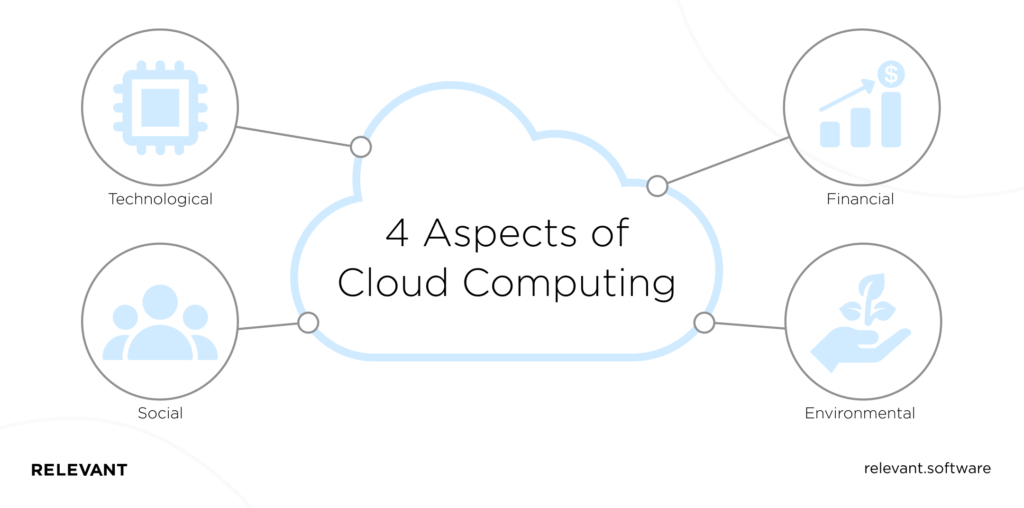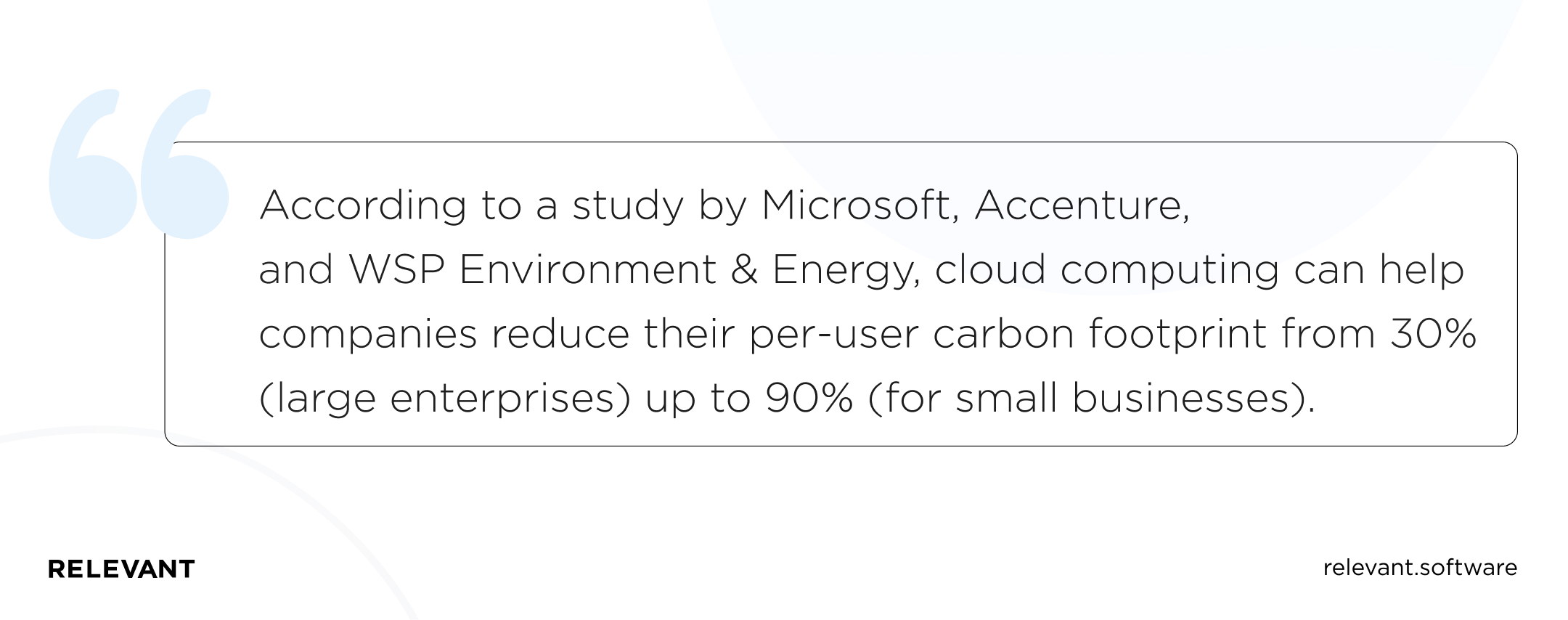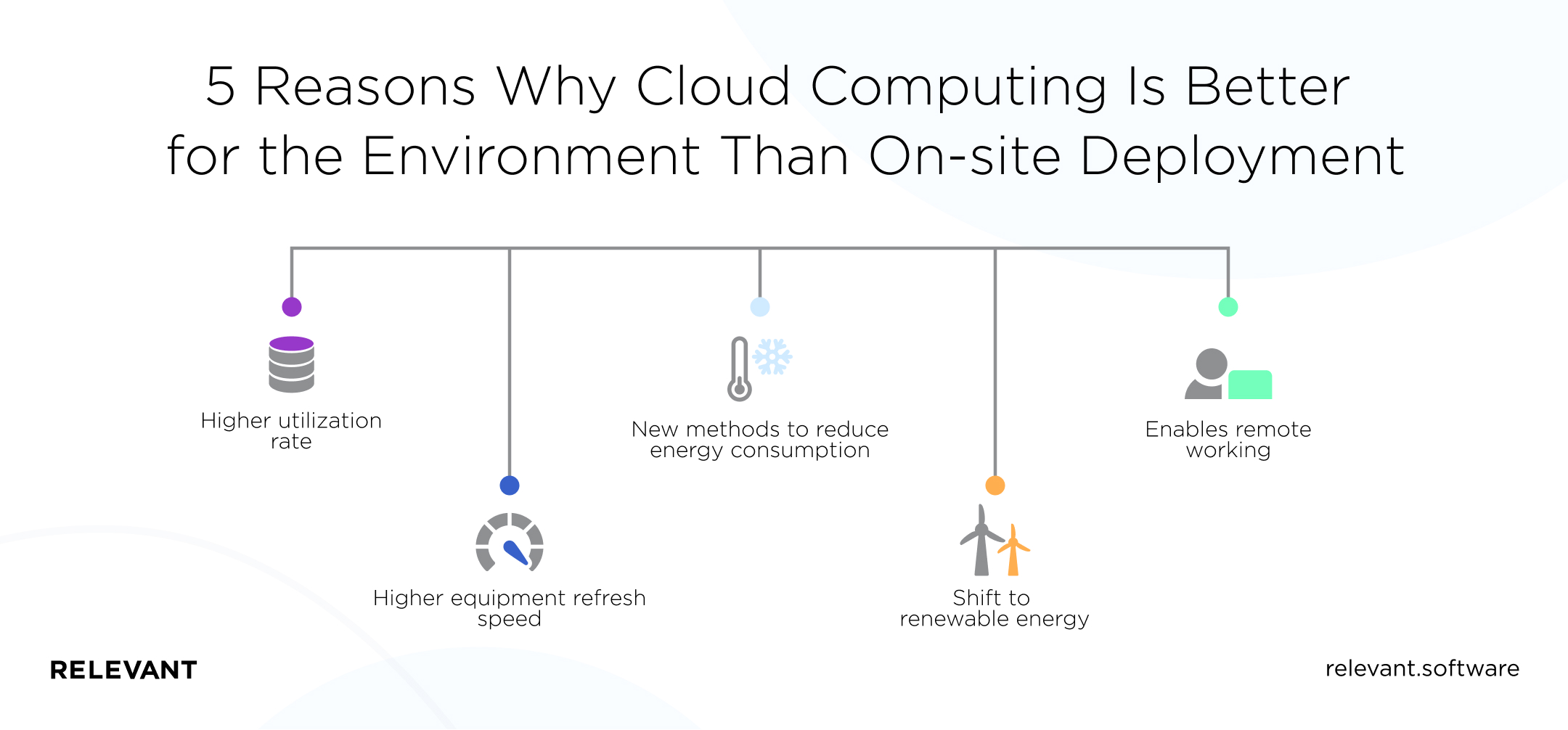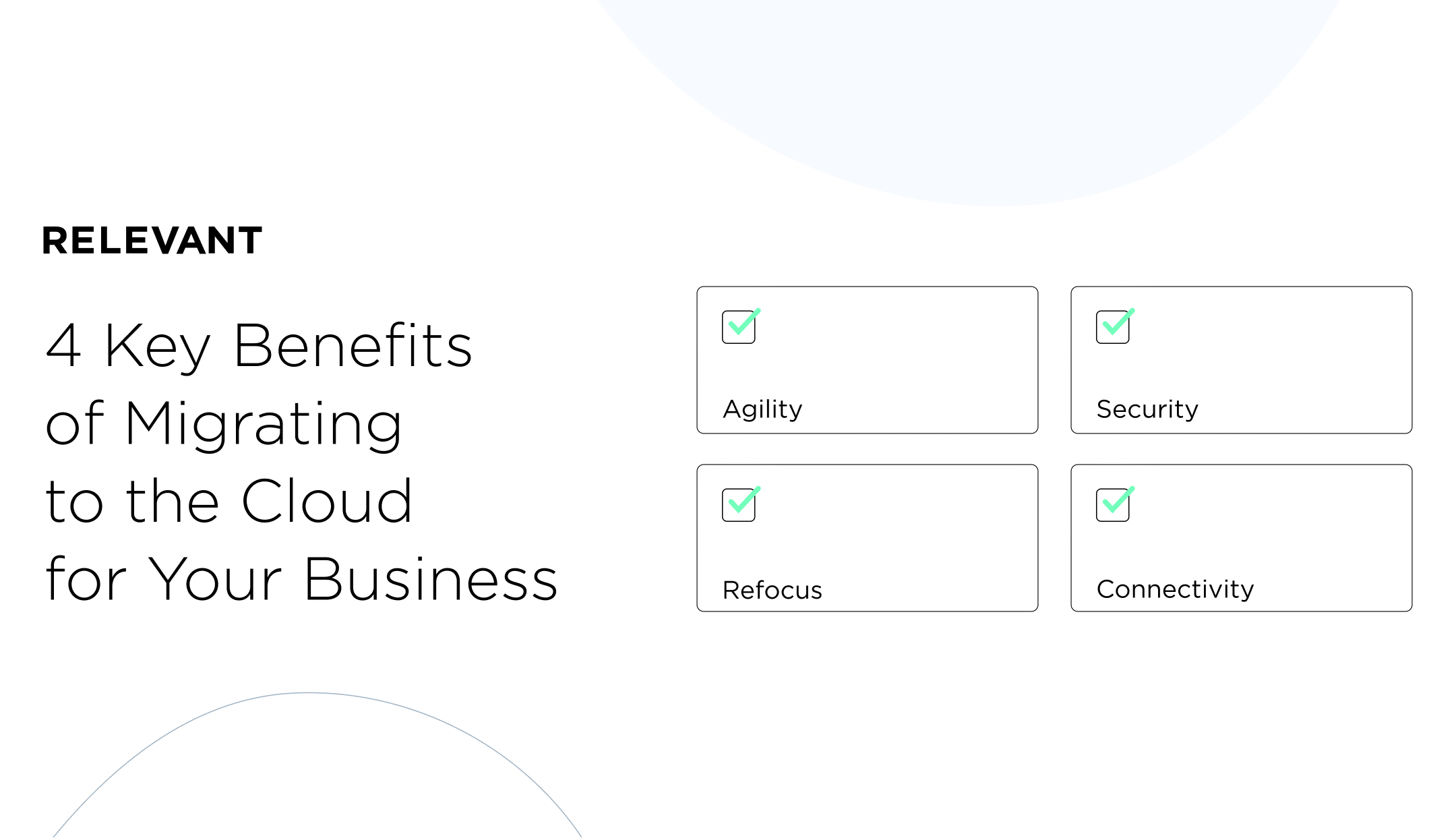Cutting Down CO2 Emissions: What Is the Environmental Impact of Cloud Computing?
Updated: August 20, 2024
The ICT sector probably isn’t the first thing to cross your mind when it comes to environmental issues. But in fact, computing’s carbon emissions account for 1.4% of the global greenhouse gas (GHG) footprint, and by 2040, this number is expected to hit 14%.
Luckily, there’s light at the end of the tunnel. Since data centers make up the largest share of this percentage (45%), you can considerably reduce your carbon footprint if you go for cloud computing.

We provide companies with senior tech talent and product development expertise to build world-class software. Let's talk about how we can help you.
Contact usBut why are data centers bad for the environment? And why is the environmental impact of cloud computing much lower? You can find the answers in this article. We’ll also guide you through the main cloud development challenges and ways to overcome them.
Table of Contents
Cloud computing and its four aspects
As an alternative to on-premise deployment, cloud computing is the on-demand delivery of IT services—such as servers, data storage space, networking, and software—over the internet.
This means that instead of buying and maintaining physical infrastructure, you can access all the necessary resources on a pay-as-you-go basis from a cloud provider like Microsoft Azure, Amazon Web Services (AWS), or Google Cloud Platform.
When compared to the on-premise infrastructure, cloud computing differs in the following aspects:
- Technological
- Social
- Financial
- Environmental

Let’s discuss each aspect in more detail.
Technological
Basically, a cloud data center is a cluster of remote, distributed computing resources available on-demand through web services. Unlike its on-premise counterpart, it can’t exist without the internet.
Social
Available online, cloud services can make it possible for less developed societies to access IT technologies and knowledge that would help them achieve further growth.
Besides, since cloud solutions allow for remote working, they became a lifeline for many businesses during the pandemic. This explains the spike in demand for cloud services in 2020: during the first quarter of 2020, the worldwide cloud services market generated its highest revenue ever.
Financial
Cloud computing allows businesses to save on purchasing, building, and maintaining IT infrastructure on their premises, as well as on hiring IT experts. According to Clay Magouyrk, SVP of Engineering at Oracle Cloud Infrastructure, moving to the cloud will save you 30-50% off your IT budget.
Environmental
You might not have realized, but cloud migration will reduce your energy consumption and thus cut down your CO2 emissions. Just look at these statistics:
- A study suggests cloud computing can help companies reduce their per-user carbon footprint from 30% (large enterprises) up to 90% (for small businesses).
- When it comes to the AWS cloud environmental impact, Amazon claims that its cloud computing resources can accomplish the same task with a 88% lower carbon footprint than their traditional counterparts.
- Based on a study from Microsoft, their cloud is 93% more energy-efficient and 98% more carbon-efficient than an on-premise data center.
- Google reported that while the number of cloud data centers increased by 550% in 8 years (from 2010 to 2018), the amount of energy that was consumed during this period grew by as little as 6%.

But why is the cloud computing environmental impact so insignificant when compared to how on-premise data centers affect our planet? Let’s unpack this in the section below.
Five ways cloud computing reduces your CO2 footprint
At first glance, cloud computing has nothing to do with sustainability. Measured in soccer fields, these massive data centers produce enormous amounts of heat and consume terawatts of power.
However, they are much more eco-friendly than their on-premise counterparts. Below are five reasons why cloud computing is better for the environment than on-site deployment.
Higher utilization rate
Traditionally, to avoid hypothetical downtime periods during usage spikes, companies use many more servers than they actually need. As a result, the on-premise data centers have an extremely low utilization rate, using on average as little as 15% of their capacity.
Since cloud providers host thousands of businesses with different usage patterns that balance each other out, they can predict their usage more accurately. Therefore, they need fewer servers (and less energy) to accomplish the same amount of work, which translates into an average equipment utilization rate of 65%.
Higher equipment refresh speed
Many companies use their on-premise servers for long periods of time. There are two reasons for that. First, as you already know, the lion’s share of their servers sits idle and, as a result, has a longer life cycle. Second, it requires significant time and budget to replace or upgrade equipment.
This approach doesn’t work with public clouds. As a high utilization rate causes faster equipment wear, cloud providers must replace their servers more frequently than on-premise data centers. And because new technologies are usually more energy-efficient than their predecessors, a faster refresh time reduces electric power consumption in the long run.
New methods to reduce energy consumption
Since cloud data centers generate a lot of heat, as much as 40% of the power they consume goes into cooling their equipment. To tackle this problem, some cloud providers use sophisticated cooling equipment with higher energy efficiency rates. Others go even further.
For example, the ACDC (the Arctic Circle Data Centre) decided to locate their server farms in the closest Norwegian town to the Arctic Circle. The US-Norwegian green IT cloud computing provider hopes that the local climate will allow them to keep their servers cool and thus decrease energy consumption by 60% (the data center has just begun operating).
Shift to renewable energy
All the major cloud service providers are gradually moving to “green” energy sources. For example, AWS is said to exceed 50% renewable energy usage and is now building four new wind farms.
Combined with the company’s existing renewable energy projects, these are expected to produce enough electricity to power 260,000 US homes for a year.
Just like AWS, Microsoft is also powered with green energy by more than 50%. What’s more, by 2050, the company is planning to remove all the carbon they’ve emitted since 1975. On top of that, Google compensated for all the CO2 they’ve produced as early as 2007.
Remote working
The last (but not the least) environmental benefit of moving to the cloud is that it enables employees to collaborate remotely. People who work from home don’t have to use transport for daily commuting, which translates into saving 3 million tonnes of CO2 emissions a year.
Additionally, by replacing air travel with video conferencing tools, you are also minimizing your carbon footprint.

Read more on energy sector software development
What are the other advantages of cloud computing for my business?
Already in 2019, as much as 94% of companies used cloud technologies. And according to Forrester, in 2021, the global public cloud infrastructure market is projected to grow by 35% to $120 billion.
This begs the question: aside from the social, financial, and environmental benefits of cloud computing, what makes the technology so attractive? Below are a few reasons why companies are increasingly migrating to the cloud:
- Agility. With cloud technologies, companies don’t wait months for new hardware components to be installed while spending significant chunks of their IT budget. Since all capacities are available on-demand, they can scale up and down whenever it’s necessary.
- Refocus. Instead of spending significant resources on keeping their on-premise infrastructures running, companies can outsource this task to cloud providers while focusing on business growth.
- Security. Large cloud providers invest heavily in security, which minimizes the risk of cyberattacks. For example, at Amazon’s AWS, cloud security is the highest priority: in 2018, the online giant acquired Sqrrl, a cybersecurity firm. Besides, if you still have cloud security concerns, you can consider private cloud solutions.
- Connectivity. You are no longer location-dependent. Users can access your cloud solution from anywhere.

Though these are just a few examples of how your business can benefit from cloud adoption, they easily demonstrate why we recommend our clients seeking web and mobile app development services to opt for the cloud.
But here’s the rub: without a good strategy (both for migration or building an off-premise solution), you won’t be able to enjoy any advantages of green cloud computing. So, how can you avoid turning one of the best business decisions into a waste of budget? Read on.
Why is it time to outsource cloud-related projects?
Whether you are planning to build ESG-compliant software and host it in the cloud or looking to move your existing on-premise solution to the cloud, be prepared for challenges. For example, you might be experiencing performance issues if your cloud servers are located too far away. Ensuring interoperability between multiple cloud providers within one solution can also be a daunting task. On top of that, your app just might not be a good fit for the cloud.
Keeping all cloud-related challenges in mind and tackling them in advance requires a decent level of cloud computing expertise. But if you don’t have the necessary talent in-house, don’t rush to hire cloud experts on your own. Instead, you can outsource cloud development (or migration) to a reliable software development provider.
A good “green tech” development outsourcing partner is able to cover the full set of cloud development tasks, including improving your current cloud solution, migrating your existing service to serverless architecture, moving from on-premise to the cloud, and building a cloud app from scratch.
You’ll be able to roll out a superior solution while accessing as many experts as you need within a limited timeframe, scaling up and down your team whenever necessary, cutting down your recruitment costs, and accelerating time-to-market. But here’s the caveat.
Since your cloud project outcome will largely depend on what provider you choose, we strongly recommend approaching the selection process very seriously. To make sure you hire an app developer you can trust, scan their portfolio for similar projects, reach out to their previous clients, and check their ratings on websites like Clutch and GoodFirms.
Wrapping up
Though it may seem that there’s no obvious connection between cloud computing and sustainability, you’ll significantly reduce your CO2 emissions if you choose cloud technologies as your deployment option.
Higher utilization rate and equipment refresh speed, renewable energy sources, novel methods to optimize energy consumption, and opportunities for remote working allow cloud providers to expand their capacities while keeping their environmental footprint at a minimum.
And that’s without mentioning other benefits of cloud computing, such as cost efficiency, agility, positive social impact, and beyond. However, to unlock all these opportunities, you’ll need cloud software development expertise. Luckily, you’ll be able to find it here, at Relevant.
Whether you need a project for ESG investing or just want to become more sustainable, we’ll provide you with the necessary cloud development talent with experience in your niche. We will help you select truly sustainable cloud providers from all those who just claim to be “green” and support your project from ideation to launch. Feel free to contact us!
FAQ
Our core services:
Do you want a price estimate for your project?
Do you know that we helped 200+ companies build web/mobile apps and scale dev teams?
Let's talk about your engineering needs.
Write to us











